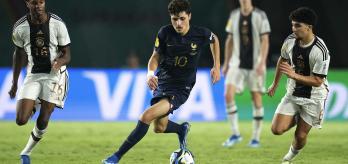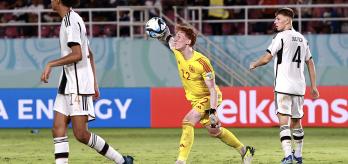The first theme identified at the FIFA U-17 World Cup Indonesia 2023™ was the impact wide players had on successful attacking play. Compared to the FIFA U-17 World Cup Brazil 2019™ (the previous tournament), wingers in Indonesia measured an increase in attacking output, goals scored and assists.
Involvement
Significantly, wide players (wide midfielders, wingers and wide attacking midfielders) were involved in 64% of attacking sequences that led to goals being scored, an 11% increase from 2019 (excluding own goals). Wingers and forwards also accounted for 29% of all goal involvements (goals and assists) in 2023, a considerable increase from the 23% recorded in 2019.
According to the Technical Study Group’s (TSG) Pascal Zuberbühler, “many teams in this tournament played with real width, and the wide players demonstrated pace, power, technical ability to go 1v1 and the attitude to dribble and take players on. It was a very strong theme. The wingers were keen to isolate opposition full-backs and, with good numbers of attacking team-mates present in the penalty area, other defenders were occupied and could not come out to help the defenders in the 1v1 situations.”
Efficiency
Generally, wide players perform more ball progressions and take-ons in youth tournaments than at the senior level. An assuring statistic from the player development perspective is that successful progressions and take-ons by wide players increased from the 2019 tournament, with completed progressions and take-ons rising from 65% to 70% and 35% to 38% respectively.
There are several reasons for an increase in success rates, according to TSG expert Julio González. “A lot of teams sent their full-backs forward when attacking and wanted to get their wingers in 1v1 situations. Centrally, defending teams often had numerical supremacy, so the wide areas presented the opportunity to create danger. Isolating and beating full-backs created overloads on the next defender inside, when they were already occupied by other attacking players.
“Winning 1v1s disturbs and distorts defensive structures. The attacking players have confidence and the hunger to create 1v1s, and their team-mates give them the ball as often as possible. They are direct and want to drive into the penalty area. These players made a real difference in games, and this is an exciting trend.”
Creating 1v1 situations was important, but a key success factor was the technical ability of the wingers once they had opposition defenders isolated in front of them. As fellow TSG expert Pape Thiaw explains, “In the clips below, we see that wide players have different behaviours, have great control of the ball and genuine variety in their game. They dribble, shoot, and provide assists and technically, these players can execute these skills with speed, confidence and power. They are also versatile; many can operate on both feet, and they create opportunities by cutting both inside and outside of opposition defenders. They want to create danger and score. It was very exciting to watch.”
SUMMARY
The ability to isolate, take on, and beat opposition defenders in 1v1s gives attacking teams opportunities to create overloads and exploit space when other defenders are occupied by attacking players. A cross-sectional analysis of FIFA tournaments (U-17, U-20 and senior levels) shows that 1v1 attacking occurs more in underage tournaments than at senior level.
However, the success rates at underage levels are increasing, indicating improved technical ability in this area, with players becoming more comfortable and accurate with both feet. Attacking players are noted to have high confidence and a distinct appetite to receive the ball and be direct without hesitation. In addition, the tactical awareness seen in the positioning of other attacking players (i.e. deliberately locking in opposition defenders) ensures that overloads are created in the final third when a take-on is successful. The combination of these factors helps explain the 6% increase from 2019 in goals and assists by wide players.









